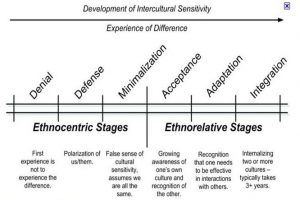
11.1 – Development of Intercultural Sensitivity
The Bennett scale also called the DMIS (for Developmental Model of Intercultural Sensitivity) was developed by Dr Milton Bennett. The framework describes the different ways in which people can react to cultural differences.
Organized into six “stages” of increasing sensitivity to difference, the DMIS identifies the underlying cognitive orientations individuals use to understand cultural differences. Each position along the continuum represents increasingly complex perceptual organizations of cultural difference, which in turn allow increasingly sophisticated experiences of other cultures. By identifying the underlying experience of cultural differences, predictions about behaviour and attitudes can be made and education can be tailored to facilitate development along the continuum.
Bennett’s Developmental Model of Intercultural Sensitivity (DMIS, 1993)
- On dynamic nature of developing intercultural sensitivity. Perception!
- The model consists of two sets (ethnocentric and ethno-relative) of three stages each:
11.1.1 – Ethnocentric:
1. Denial
People are not really aware of cultural differences and lack the terminology to describe them. They mean well but are in denial of differences.
Ex. “Oh, we’re all the same.” or “We all drink Coke.”
2. Defence
Awareness of differences, but in a ‘them-us’ way. Other cultures are seen as threatening and inferior. Perception as stereotypes. One’s own culture is still experienced as a true reality.
Ex. They don’t even speak our language.” or “They’re taking away our jobs”.
(see also ‘Reversed Defence’: seeing other cultures as superior)
3. Minimisation
Assuming a basic similarity among all humans. Awareness of differences is there, but superficial. People’s own norms and values are still universal and other cultures are interpreted through one’s own cultural glasses.
Ex. “I like soup. But for breakfast?” or “Deep down, everyone wants to use first names”.(à Why don’t they then?)
11.1.1.1 – Ethnorelative:
4. Acceptance:
People have discovered their own cultural context and can accept the existence of different cultural contexts. They recognise differences in values and behaviour and may see them as a source of new ideas and solutions to problems. Beginning of cultural relativism.
This does not mean they are in agreement; some cultural differences may be judged negatively.
5. Adaptation
People can shift their cultural frame of reference and look at the world through different eyes, and change their behaviour to communicate more effectively in another culture. There is intercultural empathy; the ability to place oneself in the value system of the other culture.
Ex.“I expect an American presentation to be entertaining, selling a key point and a Swiss one to focus on more detail, building up
to proving the point.” or “I don’t usually shake hands, but it would hurt her feelings if I don’t. So I’ll shake hands.”
6. Integration
A person moving around in cultures is no longer completely at the centre of any one or a combination of cultures. They have an intercultural identity, but know their limits, and do not find it confusing.
Ex. “I feel at home everywhere.”
What is the relevance of this model?
In which way does this theory help us work and lead better/smarter?